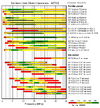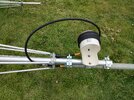First time I have encountered this. Started DXing Saturday morning and noticed after a bit there was a little bit of water spotted under the PL259 a little bit of water dripped there. As I worked you can see some drops of water coming out of the back of the PL259. This doesn't happen unless running some power. Any one else run across this and how to get rid of water in the coax? Yes I know it had to come in where evidently it connects to the beam not being waterproofed good enough. I really don't want to take the antenna down and replace the coax. Any thoughts or advice?
You are using an out of date browser. It may not display this or other websites correctly.
You should upgrade or use an alternative browser.
You should upgrade or use an alternative browser.
-
You can now help support WorldwideDX when you shop on Amazon at no additional cost to you! Simply follow this Shop on Amazon link first and a portion of any purchase is sent to WorldwideDX to help with site costs.
Water in coax
- Thread starter The20poundhammer
- Start date
Replace coax.
Seal it properly this time.
Mike
Seal it properly this time.
Mike
Once you get water through the entire length of coax like that it is pretty much done. Not really any realistic way to get that water out of there now...... and it will create corrosion and eventual disintigration of the braid......I really don't want to take the antenna down and replace the coax. Any thoughts or advice?
You need to replace the entire run of coax from beam to radio.
S&W357
$upporting Member KO4RJD....WDX-556
That would really suck if water was also dripping inside radio gear.
I always put a drip loop up where the coax connects to the antenna, making sure the top of the loop is slightly ABOVE the connector to the antenna. That way if water gets in, it only ruins the top couple feet of coax, and you can chop it off and put on a new connector..... No drip loop, or a loop with the top lower than the connector = a whole run of ruined coax.
To get the water out of the cable, you will need to cut the jacket off the entire run, then air dry it out. Hopefully, the center conductor doesn't have any water migration issues. Inspect the braid for corrosion. If there is none, seal the coax again with liquid tape, heat shrink tubing, conduit, take your pick.
Good luck!
SL
Good luck!
SL
Well the run is about 150 feet and removing the jacket is not an option. So far the SWR has not changed so that's not an issue. Just strange that it doesn't appear unless some power is running. Coax doesn't heat up just see the seepage around the connector. May be able to remove the beam off the mast and get to the driven element to unsolder the connection and put up new coax and resolder it. Sucks when one can't climb any more and have to get help to do this kind of stuff.
The water is cooling the coax, the power is heating it and expanding. The reflected power is being attenuated by the cable, which is why you don't see it on a meter.Well the run is about 150 feet and removing the jacket is not an option. So far the SWR has not changed so that's not an issue. Just strange that it doesn't appear unless some power is running. Coax doesn't heat up just see the seepage around the connector. May be able to remove the beam off the mast and get to the driven element to unsolder the connection and put up new coax and resolder it. Sucks when one can't climb any more and have to get help to do this kind of stuff.
I guessed it was heating it some even though I can't feel it. I have very little reflect less than 5 watts from 2kw out. Been a very good set up really hate to have to change this. Got 150 ft of 213/U on the way from DX Engineering. I have put drip loops in other type of cable installations but never one pointing up. Guess this will be a first. While I am at it might as well put an air choke at the feed point. Any one know how many turns and the length of them for 27mhz?
I do six or seven turns with a diameter around seven or eight inches. Some folks do more turns with smaller diameter. I use Belden RG-8 for all my coax and it doesn't like being wound too tight, hence the larger diameter coil......Any one know how many turns and the length of them for 27mhz?
Your not alone
I have done it, had a pdl II I put up, I really thought I had sealed them both up.
I was half right.
I put it up in the summer, it was fine (I thought) through winter then one day I notice the bottom of my coax switch was wet.
The horizontal cable was wicking water down the shield.... Ugh.
My Moto now is
"When you think you got enough, add one more glob of coax seal."
I got lucky, it was only 50 of coax in that run.
I actually stripped it down and used the shield for ground straps and general stuff.
I hoard, can't throw it away, I will use that for sumptin some day......
73
Jeff
I have done it, had a pdl II I put up, I really thought I had sealed them both up.
I was half right.
I put it up in the summer, it was fine (I thought) through winter then one day I notice the bottom of my coax switch was wet.
The horizontal cable was wicking water down the shield.... Ugh.
My Moto now is
"When you think you got enough, add one more glob of coax seal."
I got lucky, it was only 50 of coax in that run.
I actually stripped it down and used the shield for ground straps and general stuff.
I hoard, can't throw it away, I will use that for sumptin some day......
73
Jeff
Shadetree Mechanic
Delaware Base Station 808
Five turns at 4.5 inches is what I usually do. More turns will make the frequency too low to be effective. Will take about 8 feet.
Edit: the picture shows one I just did with 10 feet of 400 flex.
Edit: the picture shows one I just did with 10 feet of 400 flex.
Attachments
Last edited:
I usually apply silicone dielectric grease when attaching my coax ends, then I liquid electrical tape over those, and so far I have been lucky.
Maybe you have a vacuum pump, a desiccator and some calcium chloride laying around.
Maybe you have a vacuum pump, a desiccator and some calcium chloride laying around.



